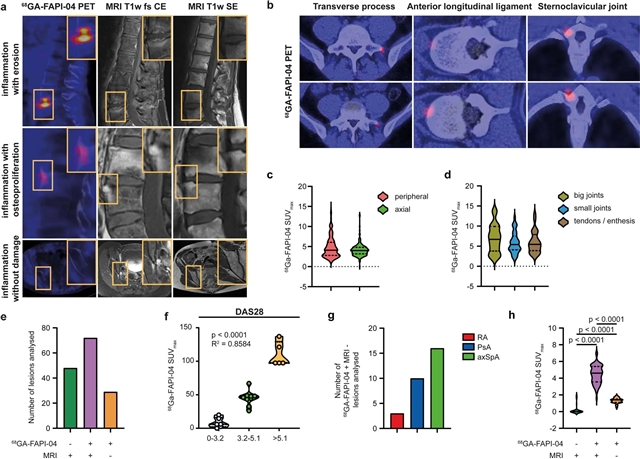
德国埃尔朗根-纽伦堡大学Andreas Ramming团队发现,CD200+成纤维细胞在关节炎中形成促进缓解的间充质网络。这一研究成果于2024年2月23日发表在国际顶尖学术期刊《自然—免疫学》上。
研究人员利用正电子发射断层扫描检测成纤维细胞活化蛋白(FAP),以此来观察人体炎症期间体内成纤维细胞的活化情况。虽然示踪剂在活动性关节炎中的积累量很高,但在肿瘤坏死因子和白细胞介素-17A受到抑制后则会降低。基于活检的实验性关节炎单细胞RNA序列分析表明,FAP信号的降低反映了从促炎症MMP3+/IL6+成纤维细胞(高FAP内化)到促溶解CD200+DKK3+成纤维细胞(低FAP内化)的表型转换。
人体关节的空间转录组学显示,CD200+DKK3+成纤维细胞与2型先天性淋巴细胞聚集在促进溶解的微环境,而MMP3+/IL6+成纤维细胞则与炎性免疫细胞聚集在一起。CD200+DKK3+成纤维细胞稳定了2型先天性淋巴细胞表型,并通过CD200-CD200R1信号传导诱导关节炎的缓解。总之,这些数据表明,在炎症消退过程中,间充质区室存在动态分子调控。
据介绍,成纤维细胞是炎症的重要调节因子,但成纤维细胞在炎症消退过程中是否会改变表型尚不清楚。
附:英文原文
Title: CD200+ fibroblasts form a pro-resolving mesenchymal network in arthritis
Author: Rauber, Simon, Mohammadian, Hashem, Schmidkonz, Christian, Atzinger, Armin, Soare, Alina, Treutlein, Christoph, Kemble, Samuel, Mahony, Christopher B., Geisthoff, Manuel, Angeli, Mario R., Raimondo, Maria G., Xu, Cong, Yang, Kai-Ting, Lu, Le, Labinsky, Hannah, Saad, Mina S. A., Gwellem, Charles A., Chang, Jiyang, Huang, Kaiyue, Kampylafka, Eleni, Knitza, Johannes, Bilyy, Rostyslav, Distler, Jrg H. W., Hanlon, Megan M., Fearon, Ursula, Veale, Douglas J., Roemer, Frank W., Buerle, Tobias, Maric, Hans M., Maschauer, Simone, Ekici, Arif B., Buckley, Christopher D., Croft, Adam P., Kuwert, Torsten, Prante, Olaf, Caete, Juan D., Schett, Georg, Ramming, Andreas
Issue&Volume: 2024-02-23
Abstract: Fibroblasts are important regulators of inflammation, but whether fibroblasts change phenotype during resolution of inflammation is not clear. Here we use positron emission tomography to detect fibroblast activation protein (FAP) as a means to visualize fibroblast activation in vivo during inflammation in humans. While tracer accumulation is high in active arthritis, it decreases after tumor necrosis factor and interleukin-17A inhibition. Biopsy-based single-cell RNA-sequencing analyses in experimental arthritis show that FAP signal reduction reflects a phenotypic switch from pro-inflammatory MMP3+/IL6+ fibroblasts (high FAP internalization) to pro-resolving CD200+DKK3+ fibroblasts (low FAP internalization). Spatial transcriptomics of human joints indicates that pro-resolving niches of CD200+DKK3+ fibroblasts cluster with type 2 innate lymphoid cells, whereas MMP3+/IL6+ fibroblasts colocalize with inflammatory immune cells. CD200+DKK3+ fibroblasts stabilized the type 2 innate lymphoid cell phenotype and induced resolution of arthritis via CD200–CD200R1 signaling. Taken together, these data suggest a dynamic molecular regulation of the mesenchymal compartment during resolution of inflammation.
DOI: 10.1038/s41590-024-01774-4
Source: https://www.nature.com/articles/s41590-024-01774-4
Nature Immunology:《自然—免疫学》,创刊于2000年。隶属于施普林格·自然出版集团,最新IF:31.25
官方网址:https://www.nature.com/ni/
投稿链接:https://mts-ni.nature.com/cgi-bin/main.plex
